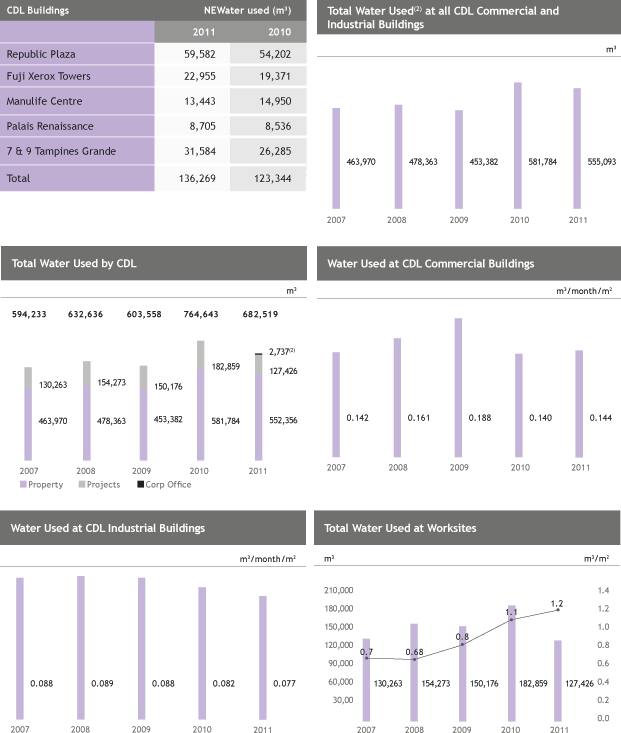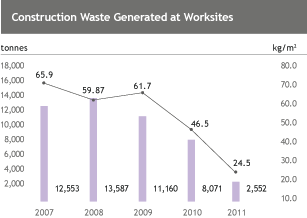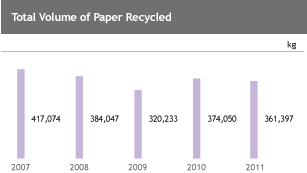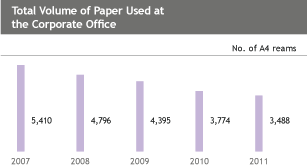

WATER
In response to water scarcity, Singapore has developed a diversified and sustainable water supply using a strategy called the Four National Taps. The water comes from four different sources; local catchment areas, imported water, reclaimed water known as NEWater(1) and desalinated water. Recognising the natural water limitation, CDL’s new developments are conceptualised with a strong focus on water sustainability right from the design stage and construction process to the building’s water efficient features.CDL’s water management strategies are based on the principles of reducing, reusing and preventing water pollution from entering Singapore’s waterways by incorporating water efficient or Active, Beautiful & Clean (ABC) Water Design features which are used during the construction phase as well as incorporated within new developments. For example, the Silt Water Treatment cum Water Recycling System was introduced for general cleaning across all worksites since 2004, water efficient sanitary fixtures and fittings have “very good” or “excellent” Water Efficiency Labelling Scheme (WELS) ratings and rainwater harvesting for plants irrigation.
A variety of Silt and Earth Control Measures are implemented on all worksites. The water discharged into the waterways has readings ranging from 10 to 15 mg/litre for Total Suspended Solids (TSS), significantly below the legal limit of 50 mg/litre. All waste water is discharged into the public sewerage system in all our investment buildings.
In 2011, CDL conserved approximately 99,237 m3 of potable water at all our worksites and used some 136,269 m3 of NEWater for operations that do not require potable water in our investment buildings such as cooling towers and sprinkler water tanks where infrastructure is available. Since 2007, CDL has conserved 470,491 m3 of potable water from five buildings by replacing it with NEWater.

| (1) | NEWater is treated used water that has undergone stringent purification and treatment process using advanced dual-membrane (microfiltration and reverse osmosis) and ultraviolet technologies. |
| (2) | Total water used by CDL. |
WASTE
Singapore has limited space for landfills and all incinerated waste that is not recovered, reused, or recycled is disposed at the four waste-to-energy incineration plants. The waste heat energy recovered from the incineration process is used to generate electricity which fulfills about 2% of Singapore’s total energy demand.CDL implements sustainable construction and environmentally-friendly site practices at our worksites. Efficient construction methods, such as the use of prefabrication and precast construction innovations are used at worksites to improve on-site management as well as to promote environmental conservation and reduce material waste. Most of the construction building components are precasted or fabricated and tested off-site, then transported to the worksite(s) to be assembled systematically. For instance, the use of prefabricated bathroom units designed to reduce construction waste have become a standard green feature in all CDL new developments wherever possible.
In 2011, construction waste(1) generated at all of CDL’s worksites amounted to 2,552 tonnes or 24.5 kg/m2 of GFA.

| (1) | Comprising non-hazardous waste. |
RECYCLING
For many years, tenants at all CDL buildings have used a paper recycling programme. All new tenants are presented with a Project: Eco-Office Kit to promote the 3Rs, namely, reuse, reduce and recycle. Recycling corners are strategically located and accessible to tenants to promote and cultivate the recycling practice. The tenant participation rate in this programme has increased from 68% in 2005 to over 90% in 2011.
GREEN PROCUREMENT
At CDL’s Corporate Office, the Company has achieved 7.6% paper reduction usage, exceeding the 5% target in 2011. Every department and employee has taken conscious effort to use less paper by utilising e-mail, e-filing, double-sided photocopying/printing and reusing paper. Posters and stickers are displayed around the office serving as an effective communication tool for our employees to conserve paper at all times. CDL’s marcom publications use eco-friendly paper, preference being for paper certified by the Forest Stewardship Council (FSC). For example, the CDL Annual Report and Sustainability Report are printed on FSC certified paper.When it is feasible, CDL has also used recycled materials as an environmentally-friendly alternative in the construction of our developments. For example, a wide range of sustainable recyclable building materials such as green concrete was used for the entire structure of 11 Tampines Concourse. Composite wood, which has over 30% recycled timber content, is commonly used for external decking in CDL developments.
